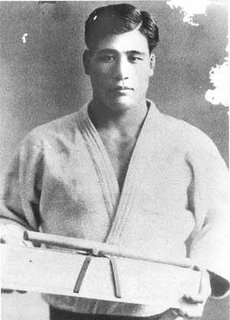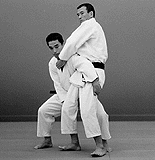Welcome Tommy & Lucas!
1. Close the Window-Hitch step into uke deep
-As you enter you want to point to the corner of uke, with weight moving forward
-Lead hand check uke's hand, opposite hand rolls shoulder back
*Take extra step if need beI remember Sensei Maria telling me that the two techniques that embody Eizan-ryu is Close the window and Kotegaesh 10. Working out with Sempai and then a new white belt really made me see the contrast in the two executions. Close the window is all about off-balance, if there is strength, the strength is "down" not against uke. The same way that when I heard "spring" in regards to doing the breakfall, When I thought "down" close the window felt more effortless.
2. Sankyu ( from cross hand wrist grab )-Cup uke's hand like you were holding up a beer
-As you raise uke's hand, push it to the back corner
-Step into uke, pinning hand to shoulder
-Twist the hand for the lock, step lead leg back for the takedown
WIth Sankyu, pinning the hand to the shoulder is my first mistake that I make, the takedown is the second. I really need to work on this. I felt that I stuttered the whole time through the technique.
3. Katana-Nage ( from cross hand wrist grab )-As uke grabs your hand, 1/2 tai sabaki into uke, bring hand down, but not out of your center
-Hitch step into uke's opposite armpit
-Cut through uke with arm ( like you were about to take a roll )
*Remember to come out of this technique with Hands up in a guard. Sensei Coleman showed me that if the technique doesn't work, bring your knee into uke's ribs.
"We servin' ribs tonight!"4. Demonstration (from straight punch )So as Janet and were working I totally missed that the technique was back and forth. A lot of times I have to muster up some spirit when I go in front of class, and my nervousness causes me to miss some things...so before I knew it Janet was punching me. I went right into a Kotegaesh, but I had grabbed more for a Tai-Otoshi, but I recovered and executed the technique. Then I did hand through the face, and I really did put my hand through Janet's face, SORRY! But something that I was chattin ' to Janet about is that I guess that's more like the "real world," someone will just haul off and throw a punch, and we need to move, and when we execute, though we excecute with peaceful intentions it is to defend ourselves.
Bonus!
5. Kata-Gatame, Kesa-Gatame & Hadaka-JimeSo I've been investigating the pinning techniques, After class I worked out with Adi on doing Kesa-Gatame to Kata-Gatame. Something Sensei Colemen showed me was in case you fall onto uke, lock them into Kesa-Gatame then escape into Kata-Gatame, then escape completely.
Say you throw uke in Ippon and they grab you and pull you on top of them-Judo Fall into them, or position yourself like judo fall
-Hook head wit your underarm, trap uke's arm into closest leg
-Pull uke into your chest for lock...OUCH!
From here to Kata-GatameKeep the hooked head, pivot body so you are perpendicular to uke, trapping uke's arm with both legs.-Take the hooked head and position your opposite arm underneath uke's exposed arm ( this will exchange the leg locking the arm for your arm locking the arm )
-Clasp hands like making hamburgers and pull into you ( this will choke uke )
From here you can move into live toe, then extend leg to get up
*If uke gives you a hard time you can re-apply the choke-Release choke and hold arm down as you escape
As Adi and I were working on Close the Window, somehow Adi ended up on all fours and I thought about this technique...
Uke is on all fours after a technique, say because they fell on their knees ( ouch! )-Snake arm around uke's throat, go so far that your deltoid is pressing against his opposite cheek ( this prevents them from pulling at the crook of your elbow to relive the choke )
-Check uke's opposite arm with your opposite arm ( you can "sweep it" if you need to )
-Mount uke and lean back, using your momentum to sink the choke
-Use butterfly guard to stop uke's legs ( my legs are not as flexible so I had to switch to full-guard )
-Clasp hands like making hamburgers and lock
As Adi and I were doing this, Adi was using pressure points to manipulate me. It was unbelievably painful to try and get these techniques, and I am sure that it was only because of his Sempai-ness that I was able to get them. Something I am thinking as I am investigating these techniques is that if you go to the ground, everything needs to be as efficient as possible because it is probably the most dangerous place to be. Broken glass on the ground is the least of your worries, there could be five guys heading your way. Be quick, and get back up!



